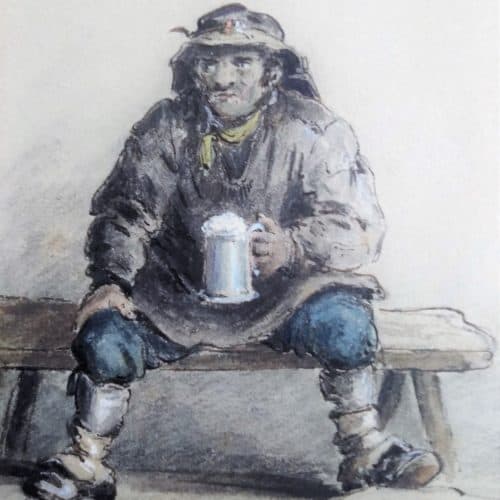Master Collection activity 12: investigating portraits of working people
Pupils compare working people in art, with those from wealthier backgrounds, inspired by examples in the Folkestone Museum Master Collection and major art museums around the world.
They investigate the work of coal porters, fisherwomen and postilions before creating their own portrait inspired by what they have seen.
Learning objectives
Increased knowledge and understanding of portraits, Victorians and history of transport.
Being able to compare and contrast artworks, including developing the critical thinking skills to do so.
Skills in creating a portrait
Curriculum links
KS1-2 Art (investigating and creating portraits)
KS1-2 History (history of transport, Victorians)
KS1-2 English (speaking and listening, discussing and debating art)
Ask pupils to compare Henderson’s image of the Coal Porter with Carracci’s study of two men, one drawing or writing and the other asleep and William Collins sketch of Boulogne fisherwomen. See Learn with Objects Master Collection 5: Fishing: Boulogne fisherwomen: Learn with Objects Master Collection 6: Sketching; and Learn with Objects Master Collection 12: Coal porter and French postilion.
- What are the differences between the images?
- How can we tell what the working lives of the different people might be like?
- Why would a coal porter have black face and hands? (coal dust)
The coal porter is slaking his thirst. Beer was brewed weak and drunk instead of water. It was healthier than water because clean drinking water was not available in London and water was contaminated with cholera. Beer also contained some Vitamin B.
- Show pupils an image of the postilion’s boots at Hever Castle in Kent, which date from 1690 and are made of iron and leather:
https://www.hevercastle.co.uk/news/castle-object-month-postilions-boots/
Their design hasn’t changed much by the 19th century.
- Look at and discuss a painting by Henderson of a Paris diligence (stage-coach) being prepared by the postilion, whose boots stand ready:
The diligence has a single shaft, with yolks for two horses. The driver’s cab has a canopy to protect him from weather. Luggage is being loaded onto the roof and covered to protect from rain.
- Another image by Henderson (Yale Center for British Art) has a side view of a French diligence on a north French sandy beach, probably picking up new cross-Channel arrivals. The coach driver’s cab has a covering to protect him from bad weather, as does the luggage on top. The postilion in his boots, contrasts with passengers:
https://collections.britishart.yale.edu/vufind/Record/3632647
- Stage coaches went regularly from one town to another. A post-chaise was a coach for private hire, usually from an innkeeper. Coaches and horses were based at town inns, where fresh horses could also be hired. Look closely with pupils at Henderson’s painting Changing Horses to a Post-Chaise outside the ‘George’:
- Stage-coach and post-chaise travelled at speed:
Create a portrait of a working person in a media of your choice.
Your subject might be a character from history (you can use the whole Learn with Objects website for inspiration) or from today. Show them with any uniform or equipment they might need for their work!
Learn with Objects links
Use Learn with Objects Master Collection 5: Fishing: Boulogne fisherwomen: Master Collection 6: Sketching and Master Collection 12: Coal porter and French postilion.

